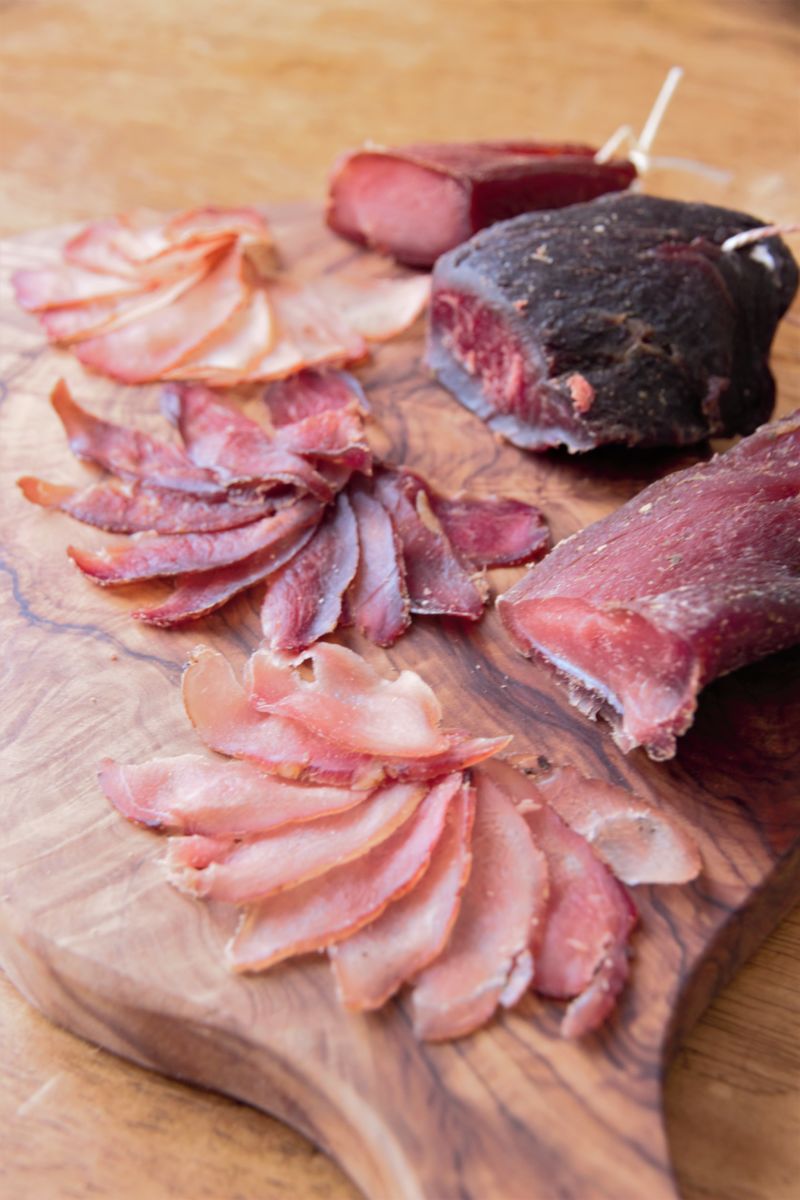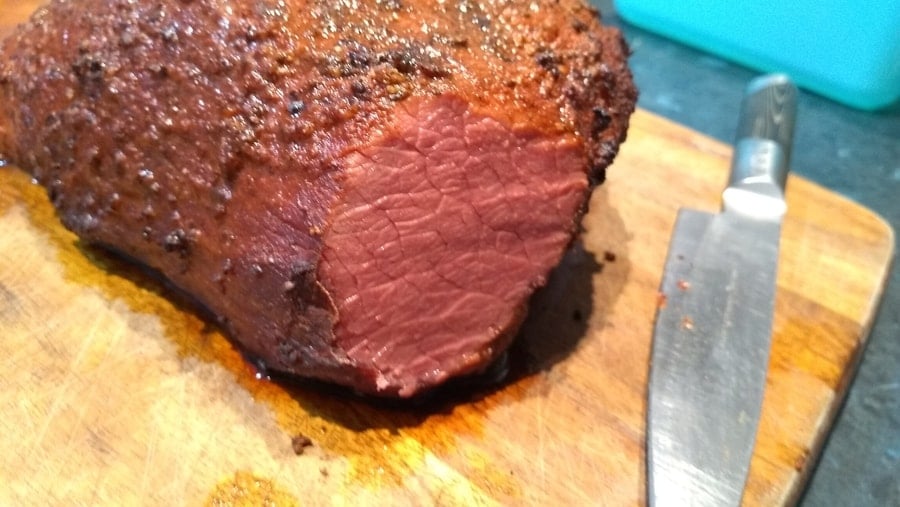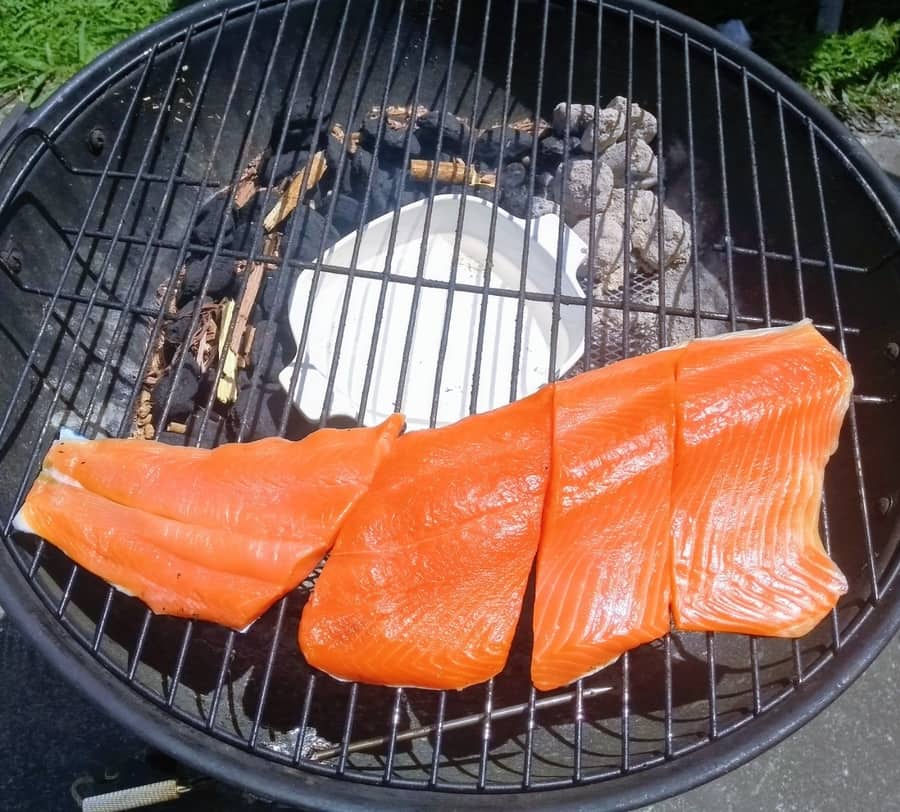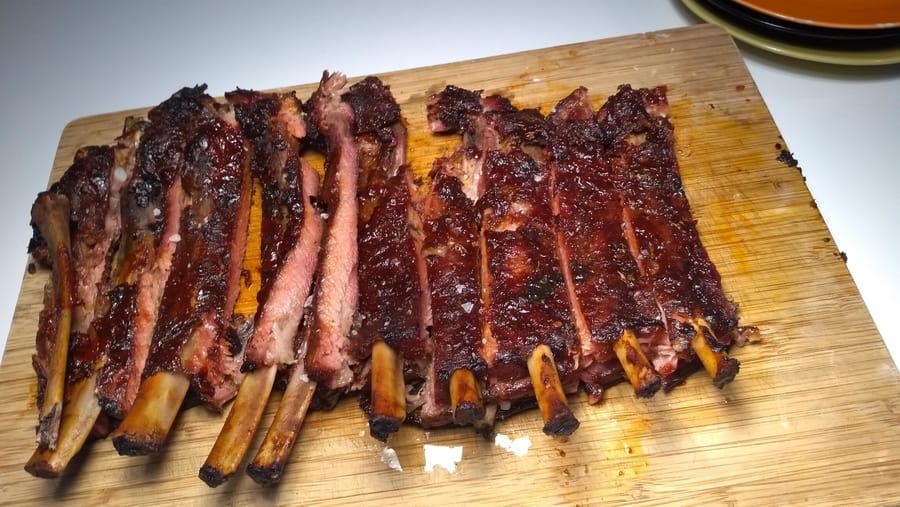Cured meat and smoked meats cross over in some ways but are also different, let’s look at both in detail.
While both methods offer their own unique advantages (and flavors) to meat, curing vs.smoking meat has unique properties that make them quite distinct from one another.
I’ve been keen on all types for year like dry cured meats made in my DIY curing chamber such as braesola or pancetta.
I also cold smoke some of these meats as well as cold smoking all kinds of foods like vegetables, cream, cheeses and mushrooms!
Then on the other side I love to smoke BBQ low and slow indirect briskets, ribs or pork.
Difference Between Cured meat vs. Smoked Meat? Cured meat is preserved through the salt primarily that inhibits meat creating an inhospitable environment for unwanted bacteria. Smoked meat can be cooked through a low heat or cured then cold smoked to dry the meat, cold smoking is not cooking but drying.
Of course, each of these adds their own outcomes and BBQ Smoking is SO much simpler then dry curing or cold smoking.
The blog is all about my passion around these, so if you’re new to the concepts – you’ find a ton of info. If you want to have a few ideas to try at home, check out this post I wrote for easy beginners projects
Continue reading to learn more about what makes these two processes unique.
What is Cured Meat?

Cured meat has been around for centuries.
Beginning long ago, people from all over the world would use the curing process to lengthen the shelf-life of their meats.
This would allow the preserved meat to last through seasonal changes as well as travel.
Additionally, some cures were used to permit the consumption of meat without the need for cooking it- although this is not always the case.
Cured meat is meat that has been applied dry or wet, it is likey to have a combination of salt, sugar, and nitrates.
Withdrawing the moisture or inhibiting the meat with salt prevents the growth of harmful bacteria, so cured meat is preserved since unwanted bacteria needs water activity to prosper..
This allows some types of cured meat to not require the same type of storage and refrigeration that other meats would need.
However, it is important to pay attention to the shelf-life and specific environmental conditions needed for product.
Curing meat has long been popular, but its practices have come from traditional curing to commercial curing. Traditional curing would require salt, herbs, and natural components that act to preserve the meat.
Commercial curing often uses artificial preservatives and nitrates to quicken the curation process, though the base of salt is still generally the same.
Dry-Cured vs. Cured to be Cooked (Prosciutto vs. Hot Smoked)



Within the larger umbrella of cured meat, there are two main categories that you will find. These include meat that has been dry-cured and meat that has been cured to be cooked.
The main difference here is that one can be eaten upon being sliced into (like prosciutto – prosciutto is eaten raw and I wrote why here)) while the other requires cooking to be appropriately consumed (like bacon).
Meats like prosciutto (among many others) that are dry-cured are ready to eat. These meats can be consumed similarly to dried jerky, biltong, dried anchovy or other dried meats.
In the dry-curing process, harmful bacteria are reduced in the meat, so the meat can be consumed immediately. This means that although the meat is not cooked, it does not hold unwanted bacteria – salt, herbs (peppercorns) acid, smoke and nitrates are the tools used to protect and preserve (article on easiest ways to preserve I wrote) dry-cured meat.
Alternatively, some meats are cured to be cooked.
Meats like traditional pork-based bacon are cured to enhance their longevity, but they still require being cooked before they are safe to consume. The curation process differs in these meats, storage requirements will also vary.
For example, you will be required to refrigerate bacon before it has been cooked, but prosciutto (here are some prosciutto substitutes I wrote about) and salami can sit on the shelf without refrigeration for quite some time.
If you have specific questions about if the meat you want to prepare requires cooking, be sure to look up your meat of choice rather than just searching for general requirements for “cured meat” as the curation process (including the meat’s storage and consumption recommendations) varies slightly for each meat.
What is Smoked Meat?
Smoked meat is another delicious option for consuming some of your favorite meats. You might even find that some of the meats you desire to eat can be cured or smoked depending on the desired flavor. And, there are some meats that are cured and smoked, though this is not as common.
Cold Smoking is done under 30°C/86°F, I prefer under 20°C for meat.
Hot Smoking (cooking with smoke), is done over 30°, often around 100° approximately (200-275°F)
- Hot Direct Smoked – Cooked (Can be Cured or Not)
- Hot Indirect Smoked / BBQ Low & Slow Smoked – Cooked (Can be Cured or Not)
- Cold Smoked – Dried (Always Cured)
Indirect (Low & Slow Smoked) Smoked meat is meat that is cooked at a low heat, most often cooked over charcoal or various types of wood.
Unlike (dry) cured meat, the aim of direct/indirect smoking meat is always to cook it, and the charcoal or wood that is used will add richness to the flavor of the meat.
For example, if you are choosing to use hickory wood, or you are using charcoal, then your meat will absorb some of the flavors of these sources.
Of course, that is often part of the desire of smoking meat in the first place as this smokey flavor creates a unique component to these meats.
But, there are plenty of ways to smoke meat- you just have to be sure you know what you are doing with your smoker and continue to check the internal temperature of the meat to ensure that it has been thoroughly cooked before removing it from the low heat.
Hot Smoked and Cold Smoked
Under the umbrella of smoked meat, you will find that you can smoke meat in a few different ways.
Two of these options include hot smoking and cold smoking. You will begin with meat that has been cured (article on if you can cure with only smoke I wrote) for cold smoking or with hot smoking it will either have a rub (dry spice sprinkled or rubbed before hot smoking or curing before cooking/smoking.
Hot smoking is what is more popularly thought about when referring to a smoker- especially for those who are only vaguely familiar with the process.
Hot smoking uses low heat to induce temperatures high enough to cook the meat. The richness of the smoke will add to the flavor of the meat during the hot smoking process
Alternatively, cold smoking lasts for a much longer period (and can even take up to 30-days to complete). Although, there is a point where smoke can’t adhere and really the cold smoke is just keeping bugs away!
In cold smoking, the meat will require curation before you can begin the cold smoking (cold smoking or charcuterie flavors; I wrote about how they taste) process- a process that takes an average of days or weeks to complete.
Often, people will choose to smoke meats that are encased, like salami and other sealed meats, by hanging several links of meat over a solid rod that extends above smoldering smoking wood (I wrote about smoking woods for cured meats here) or other cold smoking set ups.
Most people who are experienced in hot and cold smoking will recommend mastering the art of hot smoking first.
BBQ Smoked /Low & Slow Smoked (No Curing, Rub Often)

Another alternative to hot or cold smoking is BBQ smoking.
BBQ smoking does not require curing the meat and is more commonly used for meats that are going to be served immediately.
BBQ smoking can be done on a grill or with an alternative smoking device.
Here, you will be using the smoke from the charcoal or wood chips to infuse a smokey flavor into the meat. But, instead of curing the meat, you will be using a rub to infuse the desired flavor on the meat.
Then, you can plan to consume the meat once it has reached the desired temperature. BBQ smoking is considered to be a hot smoking option as it uses heat to thoroughly cook the meat rather than using a cold smoke that preserves the meat.
BBQ smoked ribs, anyone? Sign me up.

Tom Mueller
For decades, immersed in studying, working, learning, and teaching the craft of meat curing, sharing the passion and showcasing the world of charcuterie and smoked meat. Read More

I am trying to refine a Pastrami recipe, starting from a brisket cut. (not a ready made corned beef). I see so many different ratio of Instacure/salt ratio. Will your calculator provide the anticipated results for this process
Hey Brian,
You need a recipe! Most recipes won’t know about equilibrium curing, it’s about precision! That’s why I love it!
Pastrami is cured and cooked, this calculator can be used for that, check out Hank’s venison pastrami it’s using Eq Curing.
Cheers
T
still don’t understand the differences btwn sausage that is-
grilled, cooked, smoked, cured, dried, bbq, which one doesn’t need refrigeration after 2 hours?
thanks
-m
Trying to define the difference takes about 10 minutes of typing, I will try for you!
Grilled, Cooked = cooked to internal temperature = steak, pork chops etc…
hot smoked whole muscle meat = smoked/cooked to internal temperature = smoked ham, pastrami, low and slow bbq falls into this group, you can make hot smoked bacon (cooked to internal temop, then recooked for crispiness)
Dried no salt = Traditionally can be done from raw, on open fire (cold smoke lets say) – never been game enough to try it
Dried whole muscle with salt curing = dry cured meat = pancetta, prosciutto, braesola, cold smoked bacon falls into this group BUT you dont fully dry to 35% weightloss for bacon since you are cooking it
Super Dried Salt Cured Meat = Jerky – very dry like 60 or 70+% weightloss
Dry Cured salami with salt curing = same as above, salt curing, often fermentation stage to change acidity (bacteria doesnt like acidity, under 5.3 pH) = Genoa, Pepperoni, Picante.
Dry Cured and Vinegar Denatured (cooking with acid) = Biltong (South African dried meat) – like
I refrigerate pretty much everything since it slows bacteria. But I dont quite understand after 2 hours question. Salt binds to meeat cells and diffuses inside meat, it inhibits the cells so bacteria can’t spoil the meat as easily. There is salt for seasoning, then at about a point of 2%-5%, weight to meat weight it is strong enough to ‘cure’, so that it can be ‘dried’ for preservation and flavour. or 10%+ for salt pork salt for dry cured
Help these definitions help a little, I’ll think about writing a big article on this soon!
Cheers
Tom